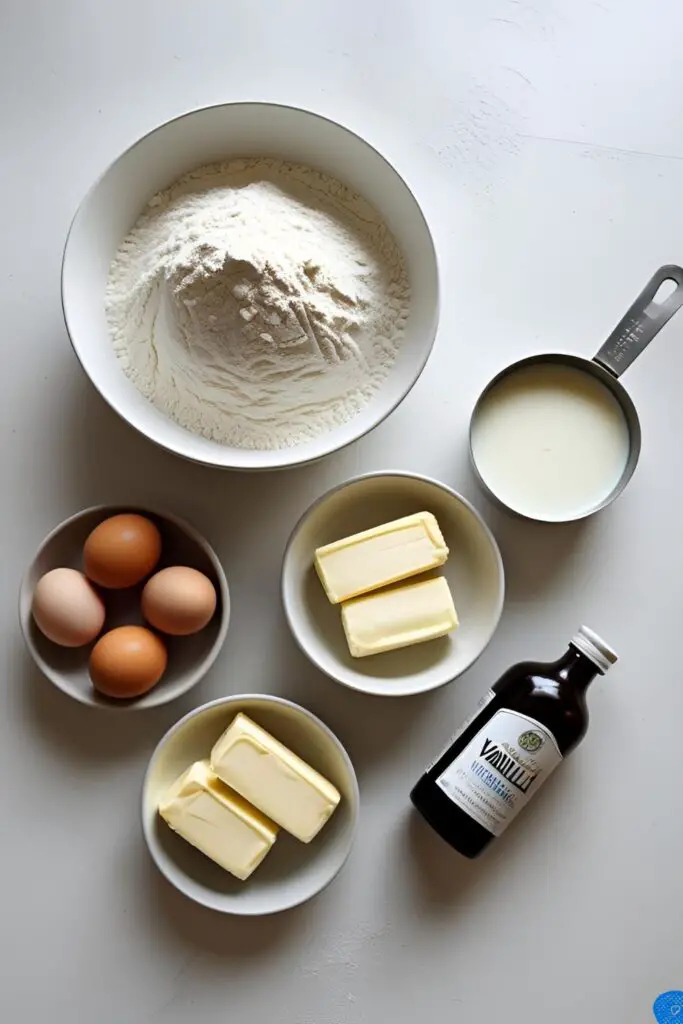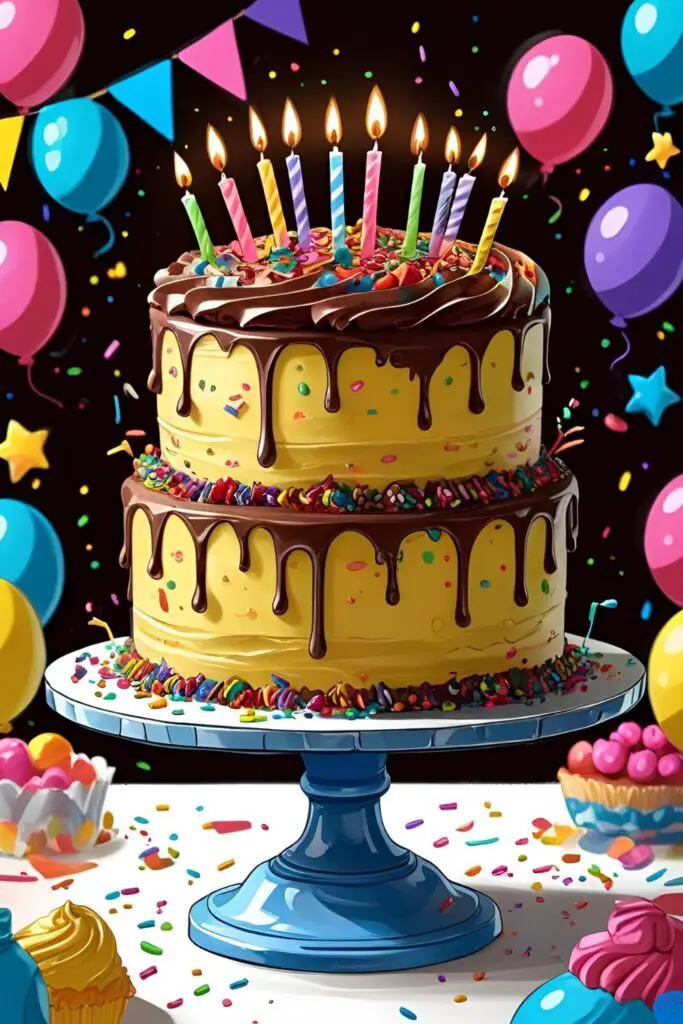How to Make Cake From Scratch: A Beginner’s Guide to the Perfect Cake!
Forget everything you think you know about baking. Forget the scary technical terms, the fear of sunken cakes, and the siren song of the box mix aisle. Today, you are going to learn how to make cake from scratch, and I promise it’s going to be way easier and more fun than you think. This isn’t about creating some ten-tiered architectural marvel you saw on a reality show. This is about mastering the fundamentals.
We’re going back to basics with the undisputed champion of celebrations: the classic yellow birthday cake with chocolate frosting. It’s the taste of pure joy and nostalgia. It’s the cake that will make you realize you had a baking superhero inside you all along.
So, are you ready to unlock a new life skill and finally understand what “creaming the butter and sugar” actually means? Let’s do this. Welcome to Baking 101.
Why This Recipe is Awesome
In a world filled with endless cake recipes, why start here? Because this one is special.
- It’s a Masterclass in the Basics: This recipe teaches you the foundational techniques of cake-making. Master this simple butter cake, and you’ll have the skills and confidence to tackle almost any other cake recipe out there.
- It Tastes Like a Happy Memory: This is the cake of childhood birthday parties. It’s buttery, rich with vanilla, impossibly moist, and has a tender, fluffy crumb that will make you wonder why you ever settled for a box mix.
- It’s a Foolproof Confidence Booster: I’ve designed this recipe to be as straightforward as possible. When you pull two perfect, golden, fragrant cake layers out of your oven, you’re going to feel like you can conquer the world. Or at least, the kitchen.
Ingredients
The players are simple, but their roles are mighty. We’re building flavor and texture from the ground up.
For the Classic Yellow Cake:
- 2 ½ cups all-purpose flour
- 1 ½ teaspoons baking powder
- ½ teaspoon baking soda
- 1 teaspoon salt
- 1 cup (2 sticks) unsalted butter, softened to room temperature
- 1 ¾ cups granulated sugar
- 2 large eggs + 2 large egg yolks, at room temperature (the extra yolks add richness!)
- 2 teaspoons pure vanilla extract
- 1 cup buttermilk, at room temperature
For the Simple Chocolate Buttercream:
- 1 cup (2 sticks) unsalted butter, softened
- 3 ½ cups powdered sugar, sifted
- ½ cup unsweetened cocoa powder, sifted
- ½ cup heavy cream or milk
- 1 teaspoon vanilla extract
- Pinch of salt
Tools & Kitchen Gadgets Used
You don’t need a professional bakery, but these tools will set you up for success.
- Stand Mixer or a powerful Hand Mixer
- Two 9-inch Round Cake Pans
- Parchment Paper
- Mixing Bowls (at least one large, one medium)
- Whisk
- Silicone Spatula
- Wire Cooling Rack
- Offset Spatula (for frosting like a pro)
Step-by-Step Instructions
Deep breaths. We’re going to walk through this together. It’s just a series of simple steps!
Step 1: Prep School First things first. Preheat your oven to 350°F (175°C). Take your two round cake pans, grease them thoroughly with butter or baking spray, then dust them with flour (tapping out any excess). For ultimate non-stick insurance, place a circle of parchment paper on the bottom. This 5-minute step is the difference between a cake that pops out beautifully and a cake-related tragedy.
Step 2: The Dry Team In a medium bowl, whisk together your flour, baking powder, baking soda, and salt. This seems like a fussy step, but it ensures you don’t get a random, bitter bite of baking soda in your finished cake. Set it aside.
Step 3: Creaming 101 (The Most Important Step!) In the large bowl of your stand mixer (or using a hand mixer), place your softened butter and granulated sugar. Beat them together on medium-high speed for a full 4-5 minutes. The mixture will transform from gritty and yellow to pale, light, and airy. You are literally whipping tiny air pockets into the fat, which is what will make your cake fluffy. Do not rush this!
Step 4: Add the Eggs and Vanilla With the mixer on medium speed, add the eggs and egg yolks, one at a time, beating for about 30 seconds after each addition until it’s fully incorporated. Scrape down the sides of the bowl, then beat in the vanilla extract.
Step 5: The Alternate Reality Now for the part that sounds fancy but isn’t. You’re going to alternate adding the dry ingredients and the buttermilk. With the mixer on its lowest speed, add about one-third of the dry mixture. Once it’s almost combined, pour in half of the buttermilk. Follow with another third of the dry mix, the rest of the buttermilk, and finish with the last of the dry mix. Mix only until the last streak of flour disappears.
Step 6: Bake It ‘Til You Make It Divide the glorious batter evenly between your two prepared pans and smooth the tops with a spatula. Bake for 30-35 minutes. The cake is done when the edges are pulling away from the sides of the pan and a wooden toothpick inserted into the center comes out clean.
Step 7: The Cool Down Let the cakes cool in their pans on a wire rack for about 15 minutes. Then, carefully run a knife around the edges and invert the cakes onto the wire rack to cool completely. You must let them cool 100% before you even think about frosting.
Step 8: Make the Frosting While the cakes cool, beat the softened butter in your mixer until creamy. Sift in the powdered sugar and cocoa powder and mix on low until combined. Add the heavy cream and vanilla, then beat on medium-high for 3-5 minutes until it’s light, fluffy, and spreadable.
Step 9: Put It All Together Place one cooled cake layer on your serving plate. Top with a generous layer of chocolate frosting. Place the second layer on top. Apply a thin, messy “crumb coat” of frosting all over the cake to trap any loose crumbs, then chill it for 20-30 minutes. Finish with a final, beautiful coat of frosting, making pretty swirls with your offset spatula.
Calories & Nutritional Info
It’s a celebration cake. Let’s not ruin the magic with too much math.
- Serving Size: 1 slice (assuming cake is cut into 16 slices)
- Estimated Calories: Around 450-550 kcal per frosted slice.
- This cake is a significant source of: Joy. And sugar. Mostly joy.
Common Mistakes to Avoid
This is your troubleshooting guide. Read it and avoid the tears of a failed cake.
- Using Cold Ingredients: I cannot say this enough. Your butter, eggs, and buttermilk MUST be at room temperature. Cold ingredients do not combine properly. Cold butter won’t cream into a fluffy texture, and cold liquids will cause the beautiful batter you just made to curdle and break.
- Under-Creaming the Butter and Sugar: If you only mix for a minute, you’re missing the magic. You need to beat it until it’s visibly paler and fluffier. This step is the foundation of a light cake texture.
- Overmixing the Final Batter: The moment you add the flour, a gluten-developing countdown clock starts. If you beat the heck out of it, you’ll get a tough, dense, bready cake. Mix on low speed and stop as soon as the flour is incorporated.
- Being a Peeping Tom: Every time you open the oven door, a rush of heat escapes, and the oven temperature plummets. This can cause your rising cake to collapse in the middle, creating a sad crater. Trust the process and only open the oven when you’re ready to test for doneness.
Variations & Customizations
Once you’ve mastered the basic cake, you own the universe.
- Ultimate Funfetti Party Cake: This one is easy. Gently fold 1 cup of rainbow jimmies (the little rod-shaped sprinkles) into the finished batter with a spatula before pouring it into the pans. It’s an instant party.
- Lemon Sunshine Cake: Add 2 tablespoons of fresh lemon zest to the sugar and rub it in with your fingers before creaming. For the frosting, skip the chocolate and make a simple vanilla buttercream, adding 1 tablespoon of lemon zest and 2 tablespoons of fresh lemon juice.
- Marble Cake Masterpiece: Make the batter as directed. Before pouring, divide it in half. To one half, gently fold in a mixture of 2 tablespoons cocoa powder and 2 tablespoons of milk. Alternate spoonfulls of the vanilla and chocolate batter into the pans and swirl once with a knife before baking.
FAQ Section
All the questions you were afraid to ask, answered.
1. What is the secret to a really moist cake? Using ingredients with high fat and acid content is key. In this recipe, the buttermilk and the extra egg yolks are the secret weapons for a moist, tender crumb. And, of course, not overbaking it!
2. Why did my cake turn out dry and dense? The most common culprits are: measuring flour incorrectly (too much flour), overmixing the batter after adding the flour, or overbaking the cake.
3. What can I use if I don’t have buttermilk? Easy fix! For every 1 cup of buttermilk, you can substitute 1 cup of regular milk mixed with 1 tablespoon of white vinegar or lemon juice. Let it sit for 5-10 minutes; it will curdle slightly and be ready to use.
4. How do I know for sure when my cake is done baking? The toothpick test is the most reliable. Insert a wooden toothpick or skewer into the very center of the cake. If it comes out clean or with a few moist crumbs attached, it’s done. If it has wet batter on it, it needs more time.
5. Why is it so important to use room temperature ingredients? Room temperature ingredients form a smooth, stable emulsion that traps air. This trapped air expands in the oven, giving your cake its light, fluffy texture. Cold ingredients resist mixing and result in a dense, heavy cake.
6. How do I prevent my cake from sticking to the pan? The triple-threat method: Grease the pan, flour the pan, and line the bottom with parchment paper. It might seem like overkill, but you’ll thank me when your cake slides out perfectly.
7. Can I make this cake ahead of time? Yes! You can bake the cake layers, let them cool completely, and then wrap them tightly in plastic wrap. They can be stored at room temperature for up to 2 days or frozen for up to 2 months. Frost the cake the day you plan to serve it.
Final Thoughts
See? You did it. You followed the steps, you trusted the science, and you made a real, from-scratch, ridiculously delicious cake. The power of the box mix has no hold on you anymore. You are a baker. You can make cake whenever you want.
This is a dangerous and wonderful new reality. Go forth and conquer the kitchen, one glorious, buttery slice at a time.




